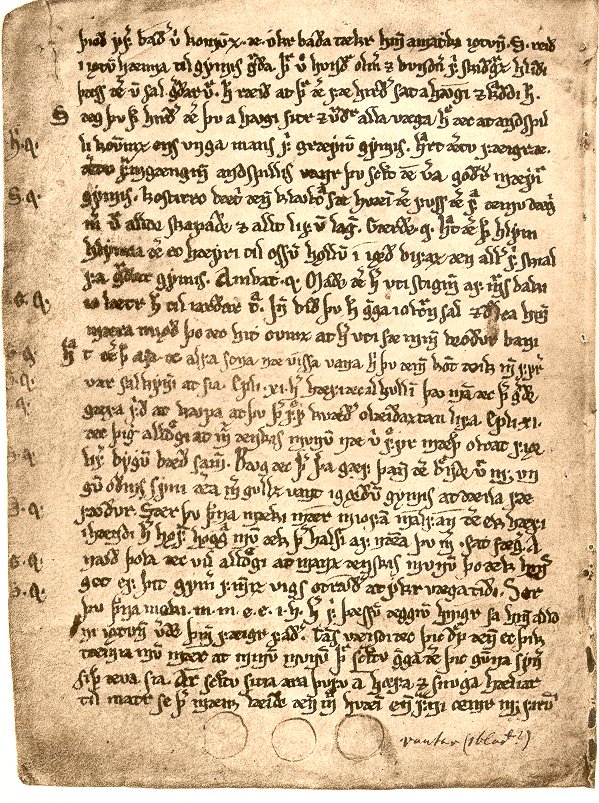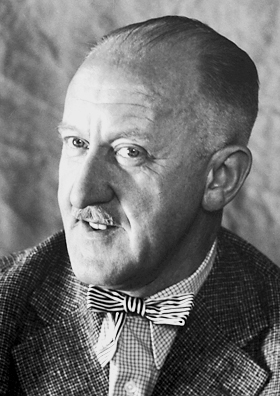|
Bergr Sokkason
Bergr Sokkason was an Icelandic monk, abbot and scholar, who flourished in the earlier fourteenth century. In 1316 he became a monk of the monastery of Þingeyri before moving to the monastery of Munkaþverá, where he became prior in 1322 and abbot from 1325–34 and again from 1345, apparently to 1350. It is not known when Bergr died: the last known mention of him is in 1345. Bergr was a close friend of Lárentíus Kálfsson and Einarr Hafliðason and seems to have been one of the most prolific identifiable authors of medieval Iceland, making him a central figure in the North Icelandic Benedictine School of saga-writing: he wrote '' Nikulás saga erkibiskups'' and '' Mikaels saga höfuðengils''; possibly '' Guðmundar saga C'', the L-version of '' Jóns saga helga'', and '' Jóns þáttr Halldórssonar''; and maybe even a number of romances: '' Kirjalax saga'', '' Rémundar saga keisarasonar'', and ''Dínus saga drambláta''. It has recently been argued that he also composed th ... [...More Info...] [...Related Items...] OR: [Wikipedia] [Google] [Baidu] |
Þingeyri
Þingeyri (, regionally also ) is a settlement in the municipality of Ísafjarðarbær, Iceland. It is located on the coast of Dýrafjörður fjord in the mountainous peninsula Westfjords (in Icelandic written Vestfirðir). On 1 January 2019, it had a population of 246. It has an airport. Continually inhabited since 1787,''Íslenska alfræðiorðabókin'', p. 563. Þingeyri is one of the oldest settlements in the WestfjordsLeffman, p. 207. and the first trading post established there.Simmonds, p. 243.Harding, p. 160. It is believed to derive its name from a medieval assembly (''þing'') and has ruins of a medieval booth believed to have been used by visitors to the assembly. Thanks to its sheltered location Þingeyri developed into a significant fishing center. In the 19th century the French applied for permission to establish a base there to support their fishing operations in the area but were turned down. From 1884-98, the town served as the base for American halibut fish ... [...More Info...] [...Related Items...] OR: [Wikipedia] [Google] [Baidu] |
Rémundar Saga Keisarasonar
''Rémundar saga keisarasonar'' is a medieval Icelandic romance saga The ''riddarasögur'' (literally 'sagas of knights', also known in English as 'chivalric sagas', 'romance-sagas', 'knights' sagas', 'sagas of chivalry') are Norse prose sagas of the romance genre. Starting in the thirteenth century with Norse tr ..., and the longest of those romance-sagas composed in medieval Iceland.Robert Cook, 'Rémundar saga keisarasonar', in ''Medieval Scandinavia: An Encyclopedia'', ed. by Phillip Pulsiano (New York: Garland, 1993), p. 526. Synopsis Kalinke and Mitchell summarise the saga thus: Rémundr falls in love with a maiden whom he has seen only in his dreams. Carrying a statue of the maiden he sets off in search of her. Rémundr kills Eskupart who claimed to be the maiden's lover, but is himself wounded. Before he died Eskupart prophesied that Rémundr could be healed only by the most beautiful woman in the world. After many adventures, Rémundr is healed in India by Elina, the ... [...More Info...] [...Related Items...] OR: [Wikipedia] [Google] [Baidu] |
Skalds
A skald, or skáld (Old Norse: , later ; , meaning "poet"), is one of the often named poets who composed skaldic poetry, one of the two kinds of Old Norse poetry, the other being Eddic poetry, which is anonymous. Skaldic poems were traditionally composed on one occasion, sometimes extempore, and include both extended works and single verses ('' lausavísur''). They are characteristically more ornate in form and diction than eddic poems, employing many kennings and heiti, more interlacing of sentence elements, and the complex ''dróttkvætt'' metre. More than 5,500 skaldic verses have survived, preserved in more than 700 manuscripts, including in several sagas and in Snorri Sturluson's ''Prose Edda'', a handbook of skaldic composition that led to a revival of the art. Many of these verses are fragments of originally longer works, and the authorship of many is unknown. The earliest known skald from whom verses survive is Bragi Boddason, known as Bragi the Old, a Norwegian skald of ... [...More Info...] [...Related Items...] OR: [Wikipedia] [Google] [Baidu] |
Icelandic Poets
Icelandic refers to anything of, from, or related to Iceland and may refer to: *Icelandic people *Icelandic language *Icelandic alphabet *Icelandic cuisine See also * Icelander (other) * Icelandic Airlines, a predecessor of Icelandair * Icelandic horse, a breed of domestic horse * Icelandic sheep, a breed of domestic sheep * Icelandic Sheepdog, a breed of domestic dog * Icelandic cattle, a breed of cattle * Icelandic chicken, a breed of chicken {{disambig Language and nationality disambiguation pages ... [...More Info...] [...Related Items...] OR: [Wikipedia] [Google] [Baidu] |
Icelandic Writers
Icelandic refers to anything of, from, or related to Iceland and may refer to: *Icelandic people *Icelandic language *Icelandic alphabet * Icelandic cuisine See also * Icelander (other) * Icelandic Airlines, a predecessor of Icelandair * Icelandic horse, a breed of domestic horse * Icelandic sheep, a breed of domestic sheep * Icelandic Sheepdog, a breed of domestic dog * Icelandic cattle Icelandic cattle ( is, íslenskur nautgripur ) are a breed of cattle native to Iceland. Cattle were first brought to the island during the Settlement of Iceland a thousand years ago. Icelandic cows are an especially colorful breed with a wide va ..., a breed of cattle * Icelandic chicken, a breed of chicken {{disambig Language and nationality disambiguation pages ... [...More Info...] [...Related Items...] OR: [Wikipedia] [Google] [Baidu] |
Finnur Jónsson (bishop)
Finnur Jónsson (16 January 1704 – 23 July 1789) was an Icelandic pastor who served as Bishop of Skálholt from 1754 to 1785. He attended the University of Copenhagen and became a pastor at Reykholt in 1732. He was reluctant to become a bishop due to the administrative duties the office entailed. He was also an accomplished scholar. In 1774, he became the first Icelander to receive a Doctor of Theology degree. From 1772 to 1778, he published ''Historia Ecclesiastica Islandiæ'', a four-volume work containing publications of the church in Iceland in Latin. Finnur's son, Hannes Finnsson, succeeded his father as Bishop of Skálholt, having been ordained a bishop in 1777. Finnur's wife was Guðríður Gísladóttir (1707–1766). See also *List of Skálholt bishops A ''list'' is any set of items in a row. List or lists may also refer to: People * List (surname) Organizations * List College, an undergraduate division of the Jewish Theological Seminary of America * SC Ge ... [...More Info...] [...Related Items...] OR: [Wikipedia] [Google] [Baidu] |
Icelandic Literature
Icelandic literature refers to literature written in Iceland or by Icelandic people. It is best known for the sagas written in medieval times, starting in the 13th century. As Icelandic and Old Norse are almost the same, and because Icelandic works constitute most of Old Norse literature, Old Norse literature is often wrongly considered a subset of Icelandic literature. However, works by Norwegians are present in the standard reader ''Sýnisbók íslenzkra bókmennta til miðrar átjándu aldar'', compiled by Sigurður Nordal on the grounds that the language was the same. Early Icelandic literature The medieval Icelandic literature is usually divided into three parts: *Eddic poetry *Sagas *Skaldic poetry The ''Eddas'' There has been some discussion on the probable etymology of the term "Edda". Most say it stems from the Old Norse term ''edda'', which means great-grandmother, but some see a reference to Oddi, a place where Snorri Sturluson Snorri Sturluson ( ; ; 1179 – 22 S ... [...More Info...] [...Related Items...] OR: [Wikipedia] [Google] [Baidu] |
List Of Icelandic Writers
Iceland has a rich literary history, which has carried on into the modern period. Some of the best known examples of Icelandic literature are the Sagas of Icelanders. These are prose narratives based on historical events that took place in Iceland and the surrounding areas during the Saga Age. Most of these sagas were recorded during the 13th and 14th centuries, but the original authors and subsequent recorders of the works are unknown and thus not listed here. Although it has been suggested that Snorri Sturluson is the author of ''Egil's Saga''. The Saga tradition is not limited only to Iceland, and is an integral part of Norse mythology throughout the Nordics. Another dominant form of Icelandic literature is poetry. Iceland has a rich history of poets, with many poets listed here. The early poetry of Iceland is Old Norse poetry, which is divided into the anonymous Eddic poetry, and the Skaldic poetry attributed to a series of skalds, who were court poets who lived in the V ... [...More Info...] [...Related Items...] OR: [Wikipedia] [Google] [Baidu] |
Þorláks Saga Helga
''Þorláks saga helga'' (the saga of St Þorlákr) is a saga about Saint Þorlákr Þórhallsson (1133–93) and the main source of evidence for his life. Versions and attestations The earliest fragment of the saga is in Latin, surviving most importantly in AM 386 4to, whose first half seems, to judge by the script, to be from around 1200. This version was probably composed in association with the translation of Þorlákr's relics by his successor Páll Jónsson. The saga then survives in Old Norse in four related medieval versions, with the following primary manuscripts: * 1: Stockholm Perg. fol. 5 (mid C14) * 2: AM 382 4to (first half of C14) * 3: AM 209 fol. (C17); AM 219 fol. (end of C14); AM 379-80 4to (C17); AM 383 III-IV 4to (early C15); AM 388 4to (C17) * 4: AM 383 I 4to (mid-C13, fragment only) The material in these also overlaps with material in a number of miracle books. It is thought that we owe the vernacular saga to the same person who composed ''Hungrvaka'' ... [...More Info...] [...Related Items...] OR: [Wikipedia] [Google] [Baidu] |
Dínus Saga Drambláta
''Dínus saga drambláta'' (also known, ''inter alia'', as ''Saga af Dínus ok Philomena'') is an Old Norse chivalric saga, assumed to have been composed first in the fourteenth century. The saga is noted for its scholarly, highbrow style. Summary According to Kalinke and Mitchell, The saga recounts the various maneuvers of Dínus, the son of the king of Egypt, and Philotemia, daughter of Maximilianus of Africa, to outwit each other. They have in common the idiosyncrasy of scorning the love of all members of the opposite sex. By means of a magic apple each succeeds in arousing the passion of the other, however. Before the two are finally joined in marriage, they encounter spells, shape-shifting, and various degradations imposed on one another. Manuscripts and transmission The saga is attested in three main versions. It was also the basis for later ''rímur''. Kalinke and Mitchell identified the following manuscripts of the saga:Marianne E. Kalinke and P. M. Mitchell, ''Biblio ... [...More Info...] [...Related Items...] OR: [Wikipedia] [Google] [Baidu] |
Kirialax Saga
''Kirjalax saga'' ('the saga of Kirjalax'), also ''Kirialax saga'' is a medieval Icelandic romance saga. It is noted for the array of scholarly sources its author(s) brought to bear. Synopsis Kalinke and Mitchell summarise the saga thus: The saga relates in a leisurely, highly rhetorical manner the fortunes of Laicus, King of Athena, and his son Kirialax. Laicus woos and, through combat, wins the hand of Mathidia, daughter of King Dagnus of Syria. After having reached maturity, their son Kirialax sets out to explore the world of his day. The account of his adventures is an extended travelogue—based on learned sources—that includes a visit to Troja and a pilgrimage to Akrsborg to see the True Cross. At the conclusion of his travels, Kirialax marries Florencia, daughter of King Lotharius of Grikkland. He is crowned king of Grikkland and the seven kingdoms subordinate to it. Two sons, Vallterus and Villifer, are born to the royal couple; they emulate father and grandfather. Man ... [...More Info...] [...Related Items...] OR: [Wikipedia] [Google] [Baidu] |



